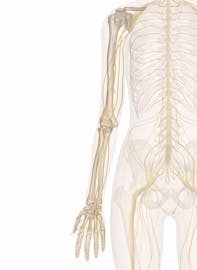The Nerves of the Arm and Hand
Explore the anatomy and structure of the arm and hand nerves with Innerbody's 3D model.

The nerves of the arm and hand perform a substantial two-fold role: commanding the intricate movements of the arms all the way down to the dexterous fingers, while also receiving the vast sensory information supplied by the sensory nerves of the hands and fingers. The movements of the arms must be fast, precise, and strong to complete the diverse activities the body engages in throughout the day. Even the tiny hand muscles, which perform very delicate and precise movements, are driven by about 200,000 neurons. Rapid conduction of sensory nerve signals from the hands provides critical information to the brain and feedback during precise activities.
Starting in the trunk of the body, the nerves of the arm and hand arise from the cervical and thoracic regions of the spinal cord as spinal nerves. These nerves merge to form a network called the brachial plexus before continuing into the arm. Five major nerves extend from the brachial plexus into the arm: the axillary, musculocutaneous, median, radial, and ulnar nerves. Each of these nerves carries information in the form of nerve impulses to and from a particular region of the arm and hand. Some of these impulses are sent from various parts of the brain and spinal cord; some come from sense organs located in the joints, ligaments, and tendons; and some come from nervous tissue in the muscles themselves.
The upper arm is served by several major nerves, including the axillary, radial, and musculocutaneous nerves. Running through the superior and posterior portions of the shoulder, the axillary nerve stimulates the deltoid muscle and receives information from sensory receptors in this region. Also running along the posterior of the arm, the radial nerve provides nerve signals to the triceps brachii muscle that extends the forearm and the skin of the posterior arm. The musculocutaneous nerve innervates the flexor muscles of the arm, including the biceps brachii and brachialis muscles.
Several major nerves continue from the arm into the forearm, including the radial, median, and ulnar nerves. These nerves control the forearm muscles that move the hands and fingers through tendons that pass through the wrist. Skin in the posterior forearm and extensor muscles of the hand and fingers are supplied by the branches of the radial nerve. Along the anterior of the forearm, the median and ulnar nerves supply nerve signals to the skin and to the flexor muscles of the hand and fingers.
As major sensory components of the body, the hands are the destination for a majority of the nerves in the upper limb. The radial, ulnar, and median nerves, having already supplied connections to the arm and forearm, continue into the hand where they form a branching network of nerve fibers. These myriad nerve fibers work together to control many delicate, precise muscles of the hand and receive signals from millions of sensory receptors that detect touch, pressure, temperature, and pain. The median nerve supplies the muscles and sensory receptors of the skin in the lateral (thumb side) palm, first, second, and third digits (thumb, index, and middle fingers), and lateral half of the fourth digit (ring finger). Along the dorsum (back) of the hand, the radial nerve supplies the muscles and sensory receptors in the lateral dorsum, and the first, second, and third digits. On the medial side of the hand, the ulnar nerve supplies the sensory receptors and muscles in the medial palm, medial dorsum, medial half of the fourth digit, and the fifth digit (pinky finger).
The sum of these nerves and sensory receptors allows the peripheral nerves in the arms and hands to collect information about the external conditions in relation to the body's internal state; to analyze this information; and to initiate appropriate responses to satisfy the body's needs. The speed at which we can, for instance, remove our hand from a surprisingly hot surface exemplifies the power of the central and peripheral nervous systems in coordination within the upper extremities. Remarkably, the nervous system transmits such messages to the brain at speeds of 180 miles per hour!












-new-upper.jpg?auto=format&ixlib=react-9.4.0&h=174&w=262)




